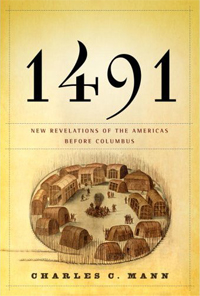
1491: New Revelations of the Americas Before Columbus
Charles C. Mann (2005)
Where to even begin?
I don't think I've ever read anything that completely shifted my perception of the world as many times as '1491' did. In more ways than I can count, this book has fundamentally altered the way I think about the continent that I've lived on for my entire life, and the people who lived here before my own ancestors arrived, and how shamefully little I was taught about those first Americans in school and college.
I honestly had never given any thought at all to what Native Americans did with the 15,000 years between coming to North America and making contact with Europeans. I assumed, based on the fact that it had never been brought up, that they basically made war, gathered herbs, used every part of the buffalo, and basically didn't change single a thing about two entire continents for up to fifteen millennia.
I could not have been more wrong.
When Europeans first arrived in the New World, they kept going on and on in their early accounts about how green and fertile this new land was, how lush and full of game; almost like a garden, or a game preserve. WELL, THERE WAS A REASON FOR THAT: Native Americans, from Alaska to Tierra del Fuego, made enormous changes to their environments, mainly through the use of controlled burns to clear forests and create open fields which were attractive to game animals like deer and rabbits. In Mesoamerica, they built complex societies with advanced mathematics, architecture, and philosophy; in the Southwest, they built entire cities into the sides of cliffs; and in the northeast, the Iroquois League created a representative democracy which would later serve as the basis for the Constitution of the United States. The list of their accomplishments goes on and on.
Possibly the greatest of Native achievements (at least within the territory of what is now the United States) was the sprawling merchant-city of Cahokia, near modern-day St. Louis. In the 1250 A.D., it was larger than London. As Mann describes it (emphasis mine):
"Anyone who traveled up the Mississippi in 1100 A.D. would have seen it looming in the distance: a four-level earthen mound bigger than the Great Pyramid of Giza. Around it like echoes were as many as 120 smaller mounds, some topped by tall wooden palisades, which were in turn ringed by a network of irrigation and transportation canals; carefully located fields of maize; and hundreds of wooden homes with mud-and-straw plastered floors and high-peaked, deeply thatched roofs like those on traditional Japanese farms. Located near the confluence of the Missouri, Illinois, and Mississippi Rivers, the Indian city of Cahokia was a busy port. Canoes flitted like hummingbirds across its waterfront: traders bringing copper and mother-of-pearl from faraway places; hunting parties bringing such rare treats as buffalo and elk; emissaries and soldiers in long vessels bristling with weaponry; workers ferrying wood from upstream for ever hungry cookfires; the ubiquitous fishers with their nets and clubs. Covering five square miles and housing at least fifteen thousand people, Cahokia was the biggest concentration of people north of the Rio Grande until the eighteenth century."
 |
| Cahokia at its peak in the 1200s A.D. |
This book comes with my highest recommendations. This book should be on the required reading list for every person who lives in the New World, or whose life has been affected by their discovery and colonization.

+(2009)+pagecover.jpg)
